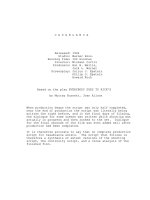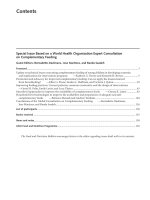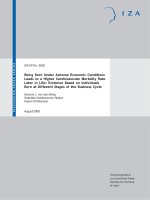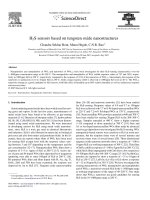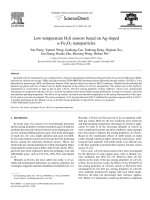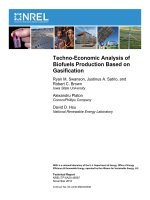chemi resistive sensors based on platinum nanoparticle arrays
Bạn đang xem bản rút gọn của tài liệu. Xem và tải ngay bản đầy đủ của tài liệu tại đây (443.29 KB, 4 trang )
Available online at www.sciencedirect.com
Procedia
Engineering
ProcediaProcedia
Engineering
00 (2011)
000–000
Engineering
25 (2011)
1129 – 1132
www.elsevier.com/locate/procedia
Proc. Eurosensors XXV, September 4-7, 2011, Athens, Greece
Chemi-resistive sensors based on platinum nanoparticle arrays
J. L. Tannera*, E. Skotadisa, S. Stathopoulosa, V. Tsoutib and D. Tsoukalasa, b
a
Department of Applied Physics, National Technical University of Athens, Zographou 15780, Greece
b
Institute of Microelectronics,NCSR “Demokritos”, Athens, Agia Paraskevi, 15310, Greece
Abstract
The design and implementation of a chemi-resistor sensor utilizing platinum nanoparticles and a poly(2-hydroxyethyl
methacrylate) (PHEMA) polymer layer is presented. The sensor was fabricated utilizing a magnetron sputtering
system for the gas phase synthesis of metallic nanoparticles and an ink-jet printer for the PHEMA polymer delivery.
The platinum nanoparticles have been deposited on oxidized silicon substrates which have been previously patterned
with gold interdigitated electrodes. Following the nanoparticles deposition a PHEMA polymer layer has been
delivered on top, using the ink-jet printing technique. By controlling the density of the metal nanoparticle film,
sensors of different sensitivity can be fabricated.
© 2011 Published by Elsevier Ltd.
Keywords: gas sensor; humidity sensor; nanoparticle; PHEMA
1. Introduction
Metallic nanoparticles of different size and of varying molecular capping have been widely
investigated over the past years as potential chemical sensing devices. Their increased sensing
performance and unique properties makes them one of the most promising transducer materials in the
field of biological and chemical sensing [1]. Previous work has investigated the application of
hygroscopic PHEMA to an array of gold nanoparticles, resulting in a measured response to small
quantities of water and ethanol vapour [2]. The nanoparticles were applied to the substrate in the form of
colloid by ink-jet printing, followed by the deposition of the polymer in the same way. The evaporative
nature of the colloid resulted in the nanoparticles being transported to the droplet edge, forming a “ring”
of higher density. The current work employs the same application of PHEMA but aims to provide a more
* Corresponding author. Tel.: +30-210-772-1679; fax: +30-210-772-3338.
E-mail address:
1877-7058 © 2011 Published by Elsevier Ltd.
doi:10.1016/j.proeng.2011.12.278
21130
Nomenclature
PHEMA
NPs
J.L. Tanner
et Procedia
al. / Procedia
Engineering
25 (2011)
1129 – 1132
J. L. Tanner
et al/
Engineering
00 (2011)
000–000
poly(2-hydroxyethyl methacrylate)
nanoparticles
uniform nanoparticle distribution, and so greater sensitivity. The nanoparticles are formed in vacuum,
based on sputtering and condensation of atoms from a metallic target to form clusters of controlled size
that are uniformly deposited on the substrate [3].
2. Experimental
Gold interdigitated electrodes with electrode gaps of 5 μm were applied by optical lithography and egun evaporation to silicon substrates with 1 μm thermal oxide layer. Platinum nanoparticles were
deposited through a second lithographic mask at room temperature using a modified magnetron sputtering
apparatus whereby the gas phase material is condensed into aggregate particles in a preliminary chamber
before arriving at the substrate [3]. The density of nanoparticles was controlled by adjusting the
deposition time between 10 minutes and 16 minutes. 1000 drops of ethyl-lactate solution with 0.5%
PHEMA concentration were deposited onto the devices using a 5 Hz printing frequency, resulting in a
functional device such as that shown in figure 1.
The devices were characterised electrically using an HP4041B picoampere meter. Sensitivity to
analyte vapors was measured by situating the devices in a small volume chamber (approximately 4 mm2)
where temperature and humidity could be carefully controlled.
3. Results
The resistance of devices with platinum nanoparticle deposition times of 10 minutes and 16 minutes
were measured as a function of temperature, shown in figure 2. Clearly the resistance decreases as the
temperature is increased; an indication that the nanoparticle film is discontinuous [4]. The gas sensing
response of the device with 10 minute platinum deposition time to water and ethanol is presented in
figures 3. Sensitivity is improved by an order of magnitude when compared with values achieved in the
Figure 1: Optical microscope photograph depicting the
finished device, showing the nanoparticle rectangular
array and PHEMA layer
Figure 2: Resistance as a function of temperature for
devices with platinum nanoparticle deposition times of
10 minutes and 16 minutes
J.L.
Tanner
et et
al.al/
/ Procedia
– 1132
J. L.
Tanner
ProcediaEngineering
Engineering25
00(2011)
(2011)1129
000–000
previous announcement [2], relating to either the lower density or larger area of nanoparticles that
contribute to the conduction path. A strong resistance change is detected at the lowest concentration of
2000 ppm for both analyte vapors.
Figure 4 shows the resistance of devices with 16 minute platinum deposition during exposure to water
and ethanol vapour respectively for 5 μm electrode gaps. Evidently the response is more moderate; this is
more clearly shown in figure 5. Relating to figure 2 it may be observed that the sample with higher initial
resistance provides a greater sensitivity to analyte gasses. The lateral expansion of the PHEMA layer
likely increases the inter-particle distance. For electrical transport mechanisms appropriate to nanoparticle
films such as this, the exponential relationship of distance with resistance ensures that greater interparticle distance results in greater sensitivity to changes in this distance [1, 5].
Electrode gap dimensions provide some degree of control to device sensitivity but the nanoparticle
density, an easily controllable parameter, is prominent in adjusting the sensitivity of devices.
Figure 3: Transient sensor response of device using 10 minute deposition of platinum nanoparticles in water vapour
(left) and ethanol vapour (right).
Figure 4: Transient sensor response of device using 16 minute deposition of platinum nanoparticles in water vapour
(left) and ethanol vapour (right).
1131
3
41132
Tanner
et Procedia
al. / Procedia
Engineering
25 (2011)
1129 – 1132
J. L. J.L.
Tanner
et al/
Engineering
00 (2011)
000–000
Figure 5: Relative resistance response for humidity and ethanol vapor concentrations from 2000 ppm up to 20000
ppm for 10 minutes deposition (left) and 16 minutes deposition (right).
4. Conclusions
The resistance of platinum nanoparticle arrays with a PHEMA functional layer has been shown to
change in the presence of small quantities of water and ethanol vapour. Expansion of the PHEMA layer
increases the inter-particle distance, resulting in an increase in resistance. Lower nanoparticle density
provides greater sensitivity.
Acknowledgements
This research has been co-financed by Marie Curie FP7-PEOPLE-3-1-IAPP, the European Union
(European Social Fund – ESF) and Greek national funds through the Operational Program “Education
and Lifelong Learning” of the National Strategic Reference Framework (NSRF) - Research Funding
Program: Heracleitus II: “Investing in knowledge society through the European Social Fund” that
supports the author E. S.
References
[1] Joseph Y, Guse B, Yasuda A, Vossmeyer T, Chemiresistor coatings from Pt- and Au-nanoparticle/nonanedithiol films:
sensitivity to gases and solvent vapors, Sens. and Actuators B 2004;98:188–95
[2] Tang J, Skotadis E, Stathopoulos S, Tsouti V, Tsoukalas D. PHEMA functionalization of gold nanoparticles for vapor
sensing: Chemi-resistance, chemi-capacitance and chemi-impedance, Sens. and Actuators B
2011;doi:10.1016/j.snb.2011.03.001
[3] Kean AH, Allers L, NSTI Nanotech Conference Proceedings, Boston, May 2006
[4] Doty RC, Yu H, Shih CK, Korgel BA. Temperature-Dependent Electron Transport through Silver Nanocrystal
Superlattices, J. Phys. Chem. B 2001;105:8291-6
[5] Lassesson A, Brown SA, Lith Jv, Schultze M. Electrical characterization of gold island films: A route to control of
nanoparticle deposition Appl. Phys. Lett. 2008;93:20311

